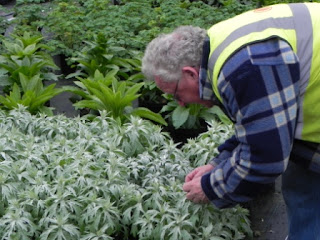Over the past few years I have shared my thoughts and experiences in the build up to Chelsea Flower Show through this blog. This year I thought I would include you all as members of the Hillier Team; your support, interest and commitment to the Show are so important to our success, whether you are staging plants, organising transport, building the foundations, taking the pictures, labelling, visiting the show, following on the internet or any one of the many other tasks involved in making it happen. Yes, there are key players in the team, but none of it can come together or be worthwhile without all of you.
 The team that actually builds the Hillier exhibit comes
together from all over: from different parts of the Hiilier Nurseries and
Garden Centres, from the Sir Harold Hillier Gardens, from gardening and the
horticultural world at large. Few of us normally work together, some of us
haven’t ever met before when we arrive on site. Some have this Chelsea
experience only once in their lives; some come back for more.
The team that actually builds the Hillier exhibit comes
together from all over: from different parts of the Hiilier Nurseries and
Garden Centres, from the Sir Harold Hillier Gardens, from gardening and the
horticultural world at large. Few of us normally work together, some of us
haven’t ever met before when we arrive on site. Some have this Chelsea
experience only once in their lives; some come back for more.
Personally I have been responsible for the
exhibit for 20 something years; before that I visited the show and sometimes
manned the exhibit in show week. My
objective has always been to create a garden exhibit which visitors can relate
to; one that will inspire but one which gives ideas that gardeners could create
in their own gardens. The story is new
each year, but the palette of plants is similar. That is the challenge: create
a new look out of the same ingredients. So far we have always succeeded.
Many believe that my primary concern is the Gold Medal. Yes,
it’s important. Last year was our 67th consecutive Gold Medal and we
currently hold the Guinness World Record for the most consecutive Gold Medals
at Chelsea Flower Show. Maybe we’ll add to that total this year, but that
depends on the plants and what we do with them.
It also depends on whether the judges like what we do. It’s my design
and choice of how it looks. I hope I get it right for all of us. My two
objectives and main concerns every year are firstly getting the job done;
believe me that’s a challenge in itself.
Secondly, and most importantly I want everyone involved to feel that
this is the best thing they’ve ever done and an experience to remember.
The theme is Risk! Our partners are Beazley, specialist
Lloyd’s insurers. I won’t bother to tell you more about the concept: If you
haven’t done so already read this:
Those of you working on the exhibit will find yourselves doing
all sorts of tasks: unloading, watering, lifting, tidying, staging, sweeping,
painting: some tasks may be wildly creative; many won’t. It’s a team effort and we all do a bit of
everything. You will never be expected to do anything beyond your capabilities.
I impress on everyone at the outset: Don’t attempt to lift anything on your own that’s too
heavy. Many of the plants are a two or
three man lift and there are about 3,500 of them. It’s not a race; take your
time. Safety is paramount. Accidents
cost time and trouble and can ruin anyone’s Chelsea experience so let’s stay
safe.
Space is limited around the exhibit. Unload and set down
plants carefully and sensibly, taking care not to cause any damage to our stock
or neighbouring exhibitors’ plants. We don’t
want any of our big, heavy, bony shrubs to be the demise of a vase of tulips or
a delicate little alpine.
There will be a fair bit of standing around for those of you
joining at the outset. There’s no planting plan and I may need a bit of
thinking time! Many of the shrubs and trees are tied up to avoid damage. Untie
them and cut off any damaged branches or broken leaves that you see. Wear gloves and look after your secateurs: I
admit I have a habit of borrowing them.
If the weather is warm and dry it can be very dusty in the
Pavilion. This is caused partly by the ground, partly by the shrubs, but most
of all by the irritating fallout from the Plane Trees. If you suffer from hay fever, asthma or any
other respiratory conditions I recommend you wear a dust mask. We will provide these but you may prefer to
bring your own.
Right the way through staging you must wear High-vis
waistcoats; we supply these rather fetching garments. You must wear safety footwear. This isn’t an RHS requirement by the weekend, but I insist that you
wear it on the Hillier exhibit.
This all sounds very dreary and I bet some will be wondering
what they are coming to. Those of you looking on may be a bit surprised: but
that’s the whole point, I want to take you with us behind the scenes..............
Tim - with the only plant he's ever lifted - typical photographer - a moment worth capturing!














